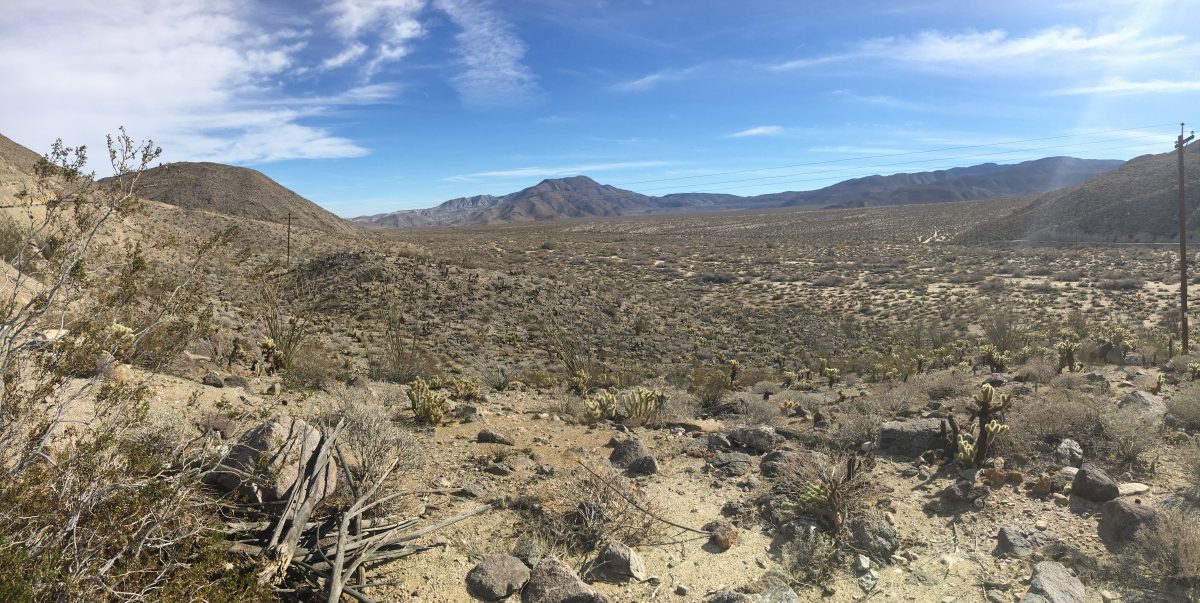Priscilla Murray and Curtis Runnels
We examined carpets of stones called “desert pavements” in Anza-Borrego Desert State Park in southern California. Archaeologists have long been interested in the fact that these pavements and others like them in the Mojave Desert to the north incorporate lithic artifacts in quantity. We picked a study area in the Sweeney Canyon area of the park in an effort to gain some insight into the behaviors of the past inhabitants there. We found that the artifacts suggest multi-purpose loci with stone tool manufacture being only one past activity.
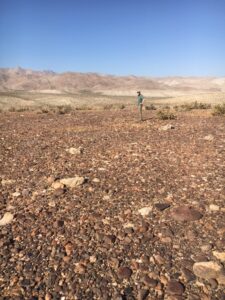
Desert pavement in Anza-Borrego
Three pavements with concentrations of lithic artifacts in Sweeney Canyon were of particular interest to us: SDi 1194 is situated on the highest and oldest fluvial (river) terrace, SDi 1195 is on the lowest and youngest terrace, and SDi 1210 is located on the middle terrace below SDi 1194 in elevation. A modern intermittent watercourse (Carrizo Creek) runs below and around all three terraces and feeds into the now-vanished Pleistocene/Holocene Lake Cahuilla to the northeast. There is a geologic fault within the study area.
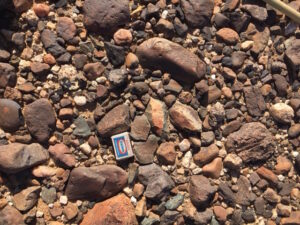
Close up of the pavement at SDi 1194 showing artifacts next to matchbox
SDi 1194, 100 meters above Carrizo Creek, is a fairly intact desert pavement and of the three locations it has the greatest density of sub-angular and rounded pebbles and cobbles and angular artifacts (cultural materials in the form of unmodified cores and flakes as well as core and flake tools). SDi 1195 has the least dense concentration and is probably an eroded lag deposit. SDi 1210 is not as tightly packed as SDi 1194 because it consists of one or more broken/eroded desert pavements with no “epipedon” preserved (see below). All three pavement locations have the same suite of artifacts. In the landscape surrounding the study sites there are scatters, sometimes in clusters, of the same types of artifacts. Many of the cobbles making up the pavements (consisting of igneous, sedimentary and metamorphic rocks) and associated artifacts (notably porphyry, basalt, and quartz) have varying degrees of desert varnish (coating) of unknown origin. In addition some cobbles and artifacts are rubefied (reddened) on their dorsal, ventral, or both surfaces presumably from contact with the underlying iron-rich soil horizon.
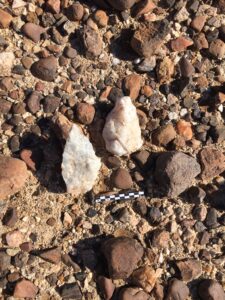
Quartz artifacts among pavement pebbles and cobbles of other materials
The pavement at SDi 1194 is relatively level and has no vegetation because of its compact nature and is larger in horizontal extent than the pavements at the other two sites. Immediately beneath the cobbles and pebbles (clasts) making up the pavement at SDi 1194, the first soil horizon is thin (5-8 cm thick) and vesicular. This Av horizon as it is called and the surface soils below it are lumped together and called the epipedon by Pelletier and his colleagues (2007) in their studies of pavements in the Mojave which is in the same desert system as Anza-Borrego. They state that airborne dust accumulation creates the epipedon which co-evolves with the pavement on top of it as clasts migrate to the surface from below. This process occurs over thousands of years. If a pavement with tightly interlocking clasts and an equally mature epipedon is disrupted it will heal relatively quickly (decades to hundreds of years). They posit therefore that some desert pavements may not have been destroyed completely with climate change at the beginning of the Holocene some 12,000 years ago and may be Pleistocene in age. The same could be true of the Sweeney Canyon pavements and the makers of the artifacts, therefore, could have visited (and re-visited) them anytime after their formation, through the Pleistocene and later into the Holocene.
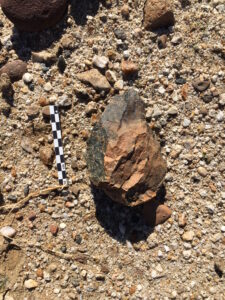
Large bifacial implement
If the toolmakers inhabited Anza Borrego in the Pleistocene, they could have been hunters of the large mammals present at the time. If, on the other hand, the toolmakers were more recent Holocene hunters and gatherers, we would expect to see archaeological evidence of their use of the Sweeney Canyon sites, but there is none. There are no stemmed arrowheads or other chipped stone artifacts of chert, obsidian and other imported materials as seen at prehistoric or historical sites in other parts of the park. There are also no potsherds, stone mortars/pestles, glass, shell, or metal artifacts. There is no rock art or fire-cracked rock, nor are there hearths, burials, or other rock features such as cairns.

Flake struck from a preferential core
The artifacts which are found at SDi 1194 are either floating on top of the pavement or are embedded in it, possibly depending on their size/shape, and may be in original context. The artifacts there, and at the other two sites, were made by reducing (knapping) cobbles, the largest stones comprising the pavements. Cores for making stone tools were both amorphous and shaped to a predetermined form for the extraction, by knapping, of flakes with preferential forms. Some of the cores were knapped on both faces into large tools that in some cases show evidence of use; these include large pointed bifacial implements (some carefully shaped, others very crude), massive scrapers, choppers, and chopping tools. Other artifacts include flakes and points that were struck from preferential cores. We also observed some small tools made from flakes through edge modification (retouching), including side scrapers, end scrapers, notched pieces, denticulates, and piercing tools. The large bifacial implements are too thick to be classified as preforms for reduction into other artifacts such as arrowheads or other projectile points (Runnels 2020). They also show evidence of use through impact fractures on their distal ends and/or re-sharpening of the edges. Differential atmospheric weathering of some flake removals may indicate artifact re-use.
Stone tool manufacture was one past activity at the three sites because, along with the finished tools, we observed remnants of all the stages of the knapping process (many unmodified/discarded cores and flakes). We also found some ovoid or spherical stones (hammerstones) used to reduce the pavement cobbles. Plant and animal food processing and base camp construction and maintenance are other possible activities at the sites which may also have served as lookouts for animals. It is known that hunters and gatherers often leave finished tools behind when they move away from a site so that they can use them during their next visit (Bailey and Galanidou 2009). Finished tools at a site can also signal use spots or territory claims to incoming visitors.
In conclusion, we may say that our close inspection of the artifacts at the sites associated with the desert pavements in the Sweeney Canyon area has confirmed what some archaeologists in the past had concluded: that the materials are not solely debris from knapping activities. We observed a variety of complete stone tools, signaling a range of human behaviors at the sites. The location of our sites near watercourses and lakes and corresponding animal pathways would have made them ideal hunting stands and base camps in the Pleistocene when the climate was wetter than in the succeeding Holocene. Yet we cannot confirm a Pleistocene age for either the pavements or the artifacts. We await the results of future geological studies of both to establish date ranges and to further evaluate the stratigraphic integrity of these artifact-rich desert pavements.
References
Bailey, G., and Galanidou. N., 2009. Caves, palimpsests and dwelling spaces:
Examples from the Upper Palaeolithic of south-east Europe. World Archaeology 41:
215–241.
Pelletier, J. D., M. Cline, and S. B. DeLong, 2007. Desert pavement dynamics: numerical modeling and field based calibration. Earth Surf. Process. 32: 1913–1927. DOI 10.1002/esp1500.
Runnels, C., 2020. The Piney Branch site (District of Columbia, USA) and the
significance of the quarry-refuse model for the interpretation of lithics sites.
Journal of Lithic Studies 7(1): 1–117. DOI 10.2218/jls2986.
